Maize traveling seminar for high-level officials in Nepal
 The Hill Maize Research Project (HMRP) led by CIMMYT, in close partnership with the the Nepal Agriculture Research Council (NARC) and the Department of Agriculture (DoA) jointly organized a five-day Maize Traveling Seminar for high-level officials in the hills of Nepal during 2-6 September 2012. The purpose of the seminar was to offer policy makers firsthand information on the status of maize varietal development, seed multiplication, marketing, technology dissemination, and the HMRP’s efforts to improve food security and livelihoods of the resource-poor and disadvantaged farmers in the hills of the country. The seminar was attended by 25 officials from the National Planning Commission (NPC), Ministry of Agriculture and Development (MoAD), Ministry of Finance (MoF), NARC, National Seed Board (NSB), DoA, donors (SDC and USAID), NGOs, private sector, and the media.
The Hill Maize Research Project (HMRP) led by CIMMYT, in close partnership with the the Nepal Agriculture Research Council (NARC) and the Department of Agriculture (DoA) jointly organized a five-day Maize Traveling Seminar for high-level officials in the hills of Nepal during 2-6 September 2012. The purpose of the seminar was to offer policy makers firsthand information on the status of maize varietal development, seed multiplication, marketing, technology dissemination, and the HMRP’s efforts to improve food security and livelihoods of the resource-poor and disadvantaged farmers in the hills of the country. The seminar was attended by 25 officials from the National Planning Commission (NPC), Ministry of Agriculture and Development (MoAD), Ministry of Finance (MoF), NARC, National Seed Board (NSB), DoA, donors (SDC and USAID), NGOs, private sector, and the media.
At the beginning of the seminar, the newly-established Ganesh Himal community-managed seed company from the mid-hill District of Dhading was inaugurated. Yamuna Ghale, senior program officer and SDC representative stressed its importance for the region: “The more than four tons of improved seed this company is expected to produce and sell to neighboring districts will help to increase the seed replacement rate in the area with resulting increases in productivity this year. This approach needs to be replicated in other hill areas of the country.” The participants then visited the National Maize Research Program (NMRP) in Rampur, Chitwan, where they observed varietal improvement and maintenance and source seed production activities. NMRP coordinator K.B. Koirala presented on the current status, priorities, and challenges of maize research and seed production in Nepal. He highlighted that the area under maize source seed production and the quality of the seed have been significantly improved, and that NMRP and other HMRP partners had reached thousands of resource-poor farmers in their respective command areas.
During the rest of the traveling seminar, participants visited HMRP partners’ activities in the hill districts of Palpa, Syangja, and Kaski, including participatory variety selection (PVS), community-based seed production (CBSP), maize-vegetables inter-cropping, and on-farm trials and demonstrations activities conducted by CBSP groups and cooperatives. In the Manakamana Women Farmers Group of Syangja district, about 45 women members gathered to welcome the participants of the seminar. During interactions with the farmers, they learnt about farmers’ constraints and needs for marketing the seed, improving yields, storage facilities, credits, inputs, training etc. Amy Prevatt, USAID-Nepal representative, expressed her satisfaction with the accomplishments of HMRP and its partners regarding reducing poverty and food insecurity in the hills of Nepal. “I am sure the project will continue supporting you to overcome the marketing constraints and to make your CBSP group stronger and sustainable,” she said. The team and the farmers carried a walk around the village to observe crop conditions in CBSP, PVS, and intercropping trials. The team then headed for the Palpa district to visit the Radha Krishna Women farmers groups and Shiva Sakti maize seed producers group in Chatiwan, which has recently graduated into a cooperative with technical assistance from HMRP and its partners.
The seminar was concluded with a business meeting co-chaired by Tek Bahadur Gurung (NARC director of livestock and fisheries) and Dharma Dutta Baral (deputy director general at DoA under MoAD). During the meeting, participants assessed the effectiveness of the seminar; most of them expressed their satisfaction over its achievements, shared recommendations for further improvement, and suggested that the seminar be conducted annually during the main maize season. “The seminar provided good information that can only be appreciated by observing it at the field level,” said Baral. Gurung summed up the meeting by thanking the seminar organizers and stating that “the NARC and the MoAD are proud of the close partnership we have maintained with CIMMYT over the past 27 years. Events like the traveling seminar give us the opportunity to witness some of the fruitful results of this partnership.”
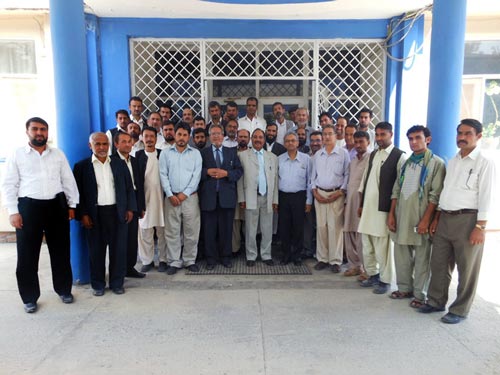
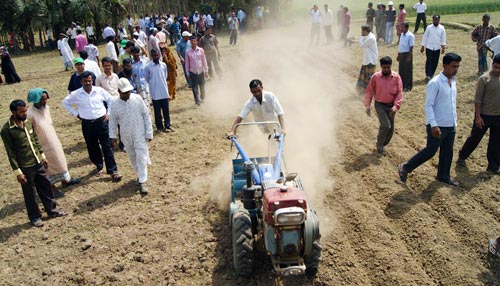 The CIMMYT team in Bangladesh hosted a highprofile field visit on September 1, 2012, for a United States Agency for International Development (
The CIMMYT team in Bangladesh hosted a highprofile field visit on September 1, 2012, for a United States Agency for International Development (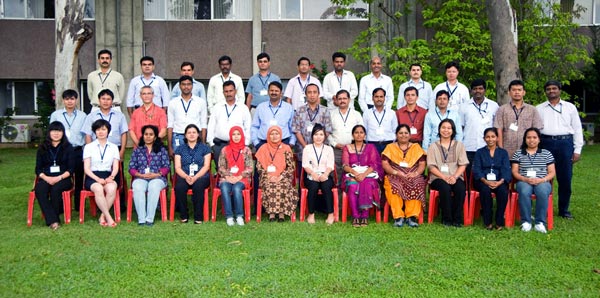
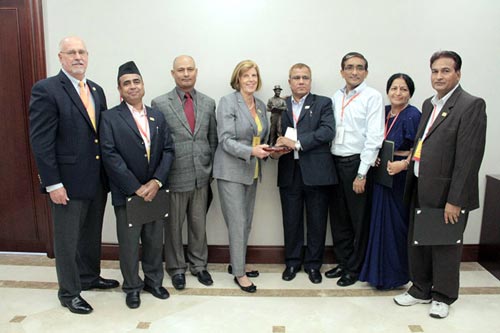 The first-ever
The first-ever 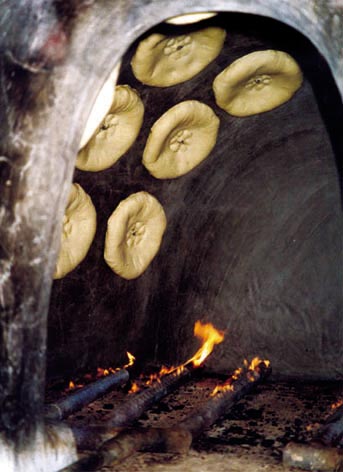 The 11th International Gluten Workshop (IGW) jointly organized by the Chinese Academy of Agricultural Sciences (CAAS),
The 11th International Gluten Workshop (IGW) jointly organized by the Chinese Academy of Agricultural Sciences (CAAS), 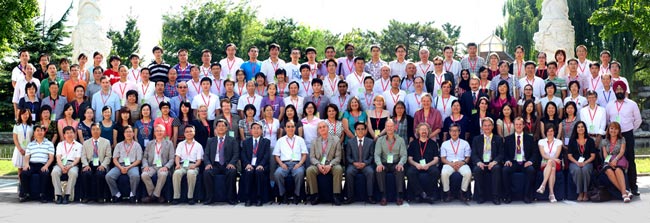
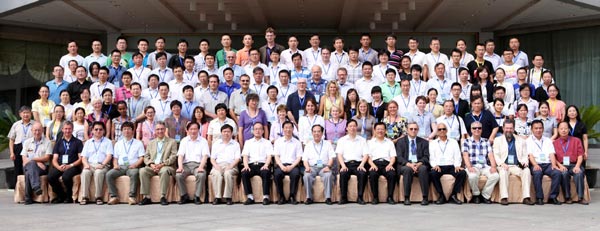
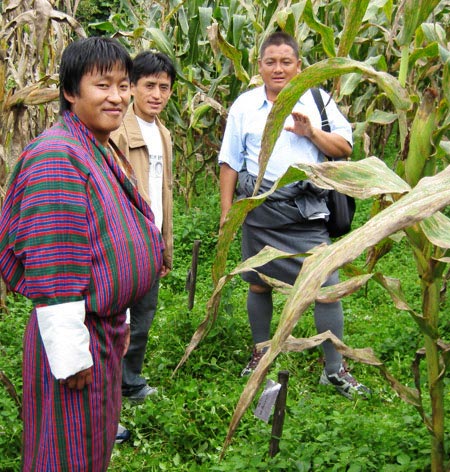 Maize is one of the major staples in Bhutan and is cultivated by about 70 percent of households throughout the country. Poor farmers sustain their families by consuming maize as a staple food, using it as animal feed, and selling it for further income. Thus, the 2007 outbreak of Gray Leaf Spot (GLS), a new disease caused by Cercospora zeae-maydis, posed a major challenge to the Bhutanese maize program and maize farmers, many of whom lost over 70 percent of their production.
Maize is one of the major staples in Bhutan and is cultivated by about 70 percent of households throughout the country. Poor farmers sustain their families by consuming maize as a staple food, using it as animal feed, and selling it for further income. Thus, the 2007 outbreak of Gray Leaf Spot (GLS), a new disease caused by Cercospora zeae-maydis, posed a major challenge to the Bhutanese maize program and maize farmers, many of whom lost over 70 percent of their production.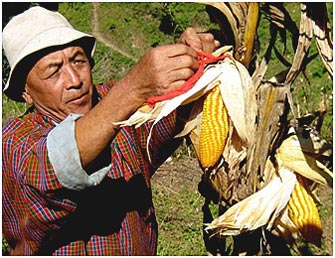 The replacement of seeds has been facilitated through Community Based Seed Producers (CBSP) groups. In 2011 and 2012, over eight tons of seed was supplied to GLS-affected farmers in 10 districts. The average yield recorded under farmers management was 3.73 t/ ha for S03TLYQAB05, and 4.43 t/ ha for ICAV305. Production of basic and foundation seeds has started at research farms and will serve as seed source for the CBSP groups. By 2013, the National Maize Program aims to replace 80 percent of the seeds for GLSaffected farmers cultivating maize above 1,500 masl. The program cooperates with the National Seed Center and CBSP groups to achieve higher efficiency in seed replacement.
The replacement of seeds has been facilitated through Community Based Seed Producers (CBSP) groups. In 2011 and 2012, over eight tons of seed was supplied to GLS-affected farmers in 10 districts. The average yield recorded under farmers management was 3.73 t/ ha for S03TLYQAB05, and 4.43 t/ ha for ICAV305. Production of basic and foundation seeds has started at research farms and will serve as seed source for the CBSP groups. By 2013, the National Maize Program aims to replace 80 percent of the seeds for GLSaffected farmers cultivating maize above 1,500 masl. The program cooperates with the National Seed Center and CBSP groups to achieve higher efficiency in seed replacement.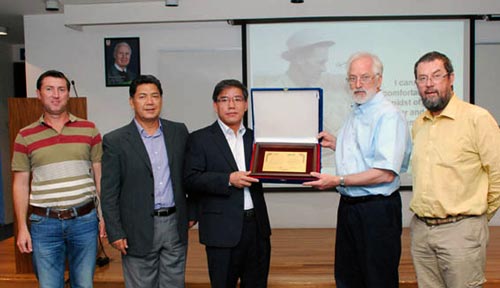 RDA is a central government organization responsible for agricultural research and services. Since its foundation, it has helped South Korea to achieve self-sufficiency in rice and other staple food production through dissemination and promotion of high-yielding cultivars and improved cropping technologies, and contributed to the improvement of the rural environment.
RDA is a central government organization responsible for agricultural research and services. Since its foundation, it has helped South Korea to achieve self-sufficiency in rice and other staple food production through dissemination and promotion of high-yielding cultivars and improved cropping technologies, and contributed to the improvement of the rural environment.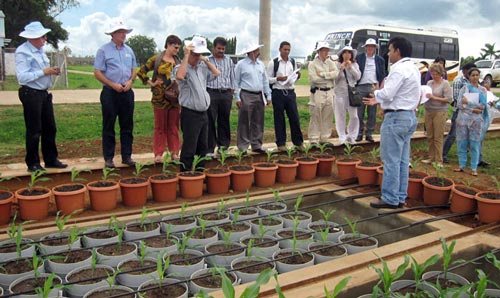 After a formal introduction, Zaidi gave an overview of the research program and priorities of the CIMMYT-Asia maize program, and the ongoing collaborations with various public and private institutions in the region, including the International Maize Improvement Consortium (IMIC-Asia). He emphasized CIMMYT’s initiatives towards purposeful partnerships, which offer a big opportunity for pro-poor agricultural investment and innovations (such as IMIC-Asia and MAIZE), the global alliance for food security, and the livelihood of resource-poor in the developing world.
After a formal introduction, Zaidi gave an overview of the research program and priorities of the CIMMYT-Asia maize program, and the ongoing collaborations with various public and private institutions in the region, including the International Maize Improvement Consortium (IMIC-Asia). He emphasized CIMMYT’s initiatives towards purposeful partnerships, which offer a big opportunity for pro-poor agricultural investment and innovations (such as IMIC-Asia and MAIZE), the global alliance for food security, and the livelihood of resource-poor in the developing world.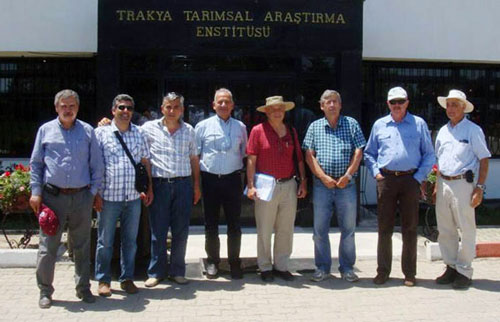 The
The 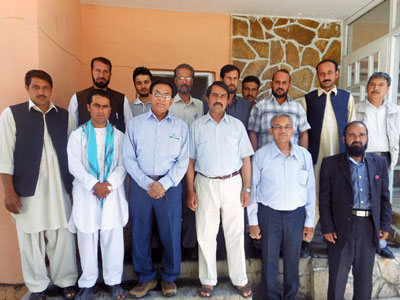 Dr. Mishra began the course by reviewing basic statistical concepts and discussing the statistical tools and concepts needed to design and analyze field experiments that would lead to scientifically valid interpretations. He went on to describe how to choose experimental designs, lay out field experiments, and analyze and interpret the results. He had the participants do useful exercises as well as analyze data for hands-on experience. All the participants were keenly interested and excited to have the opportunity to analyze and interpret data from their own experiments. The general feeling at the end of the two-day event was that it should have lasted at least a week. Upon presenting certificates to course participants, Mr. Qasem Obaidi, ARIA Director, thanked Dr. Mishra and CIMMYT for the capacity building effort and expressed his wish that a follow-up course be held to help consolidate the gains and enable Afghan researchers to learn more about experimental design and analysis.
Dr. Mishra began the course by reviewing basic statistical concepts and discussing the statistical tools and concepts needed to design and analyze field experiments that would lead to scientifically valid interpretations. He went on to describe how to choose experimental designs, lay out field experiments, and analyze and interpret the results. He had the participants do useful exercises as well as analyze data for hands-on experience. All the participants were keenly interested and excited to have the opportunity to analyze and interpret data from their own experiments. The general feeling at the end of the two-day event was that it should have lasted at least a week. Upon presenting certificates to course participants, Mr. Qasem Obaidi, ARIA Director, thanked Dr. Mishra and CIMMYT for the capacity building effort and expressed his wish that a follow-up course be held to help consolidate the gains and enable Afghan researchers to learn more about experimental design and analysis.